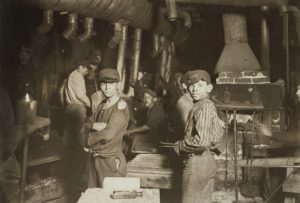
It’s easy to treat Labor Day as little more than the last summer holiday. As one more opportunity to visit the lake. As a day for barbecues or sipping lemonade on the hammock. After all, Labor Day lacks the historical traditions of Independence Day or the gravity of Memorial Day. It’s just not quite as important. Right?
Wrong.
As you know, Labor Day is really a celebration of the Labor Movement. What you may not know is that one of Labor’s many accomplishments centers around the thing we hold most dear:
Our children.
These days, most kids in the United States spend their childhood going to school, romping on the playground, riding bikes, or any of a thousand other fun activities. The entire concept of growing up is based on learning, exploration, and recreation.
But it didn’t used to be that way.
In 1900, at least 18% of children worked as child laborers – and that figure is probably low. In the 18th century, hundreds of thousands of children worked in mills and factories, mines and farms. They spent ten, twelve, fourteen hours every day in dangerous conditions for very little money. Many child laborers grew up with callused fingers, poor eyesight, and rotting lungs.
Most never received an education.
Here’s how one historian put it:
Although children had been servants and apprentices throughout most of human history, child labor reached new extremes during the Industrial Revolution. Children were useful as laborers because their size allowed them to move in small spaces in factories or mines where adults couldn’t fit, children were easier to manage and control and perhaps most importantly, children could be paid less than adults. Child laborers often worked to help support their families but were forced to forgo an education.
It’s largely thanks to the Labor Movement that child labor has become – for the most part – a thing of the past. Thanks to decades of lobbying and protesting, the Labor Union was able to prod the government into passing an ever-more stringent series of laws prohibiting child labor. For example:
In 1832, New England unions resolved that, “Children should not be allowed to labor in the factories from morning till night, without time for healthy recreation and mental culture,” for it “endangers their well-being and health.”
In 1836, many trade unions started making formal proposals in favor of minimum age laws. Later that year, Massachusetts became the first state to require children under 15 to attend school at least 3 months every year.
In 1842, some states passed laws limiting children’s work days to 10 hours.
In the 1870s and 80s, as the Labor Union became a more unified force, many unions proposed banning child labor altogether. When the American Federation of Labor was formed in 1881, its leader, Samuel Gompers, wrote: “What does labor want? We want more schoolhouses and less jails. More books and less arsenals. We aim to…take children from the factory and workshop and give them the opportunity of the school and the playground.”
In 1904, the National Child Labor Committee began an aggressive campaign for more stringent laws against child labor.
I could go on, for pages and pages. Suffice it to say that in 1938, after a century of struggle, the Labor Movement helped ensure the passage of the Fair Labor Standards Act. This landmark legislation made it illegal for most industries to employ children under 14. It also imposed a host of other rules against employing older children in dangerous jobs or for long hours.
As you enjoy Labor Day, take a moment to watch your children and grandchildren frolic and play. Ask them about school starting. And reflect that these simple joys are largely due to the hard work of laborers.
This Labor Day let’s all give thanks for one of the greatest blessings we enjoy: Childhood.
From all of us here at Wealth Advisors, I wish you a safe and happy Labor Day!
Note:
We will be closed on Monday, September 3rd for the Labor Day Holiday
and back in the office on Tuesday, September 4th.




